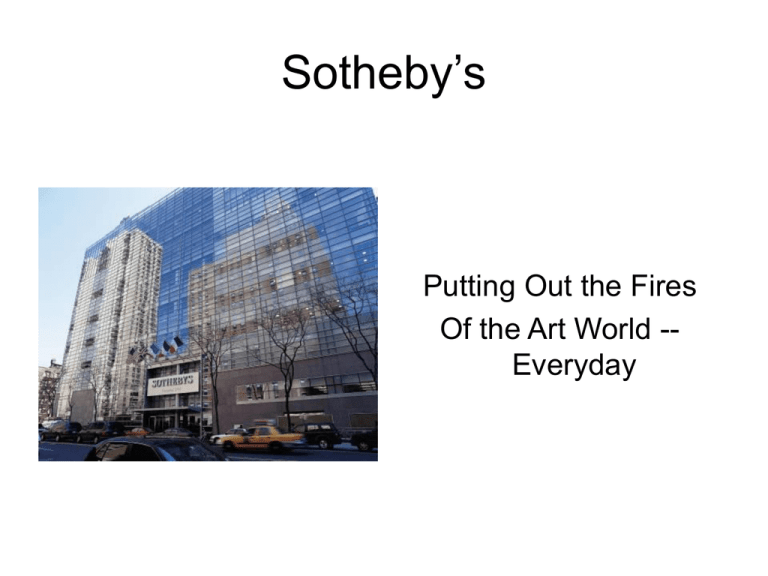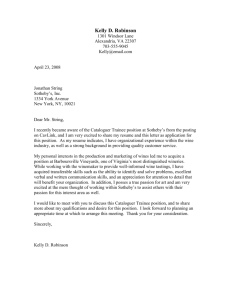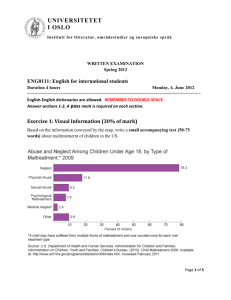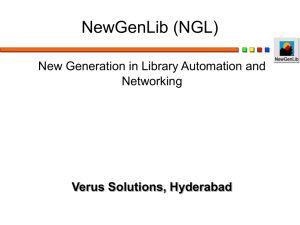Sotheby`s - MetaMatrix Consulting Group
advertisement

Sotheby’s Putting Out the Fires Of the Art World -Everyday Sotheby’s: Day-to-Day Challenges The difficulty in planning for long-term success for Sotheby’s and for the entire auction business is due to the inherent nature of the auction business – UNPREDICTABILITY The Three D’s and other Effects on the Auction Business • Death • Divorce • Debt • Availability of Property in the Market • Stability of Global Financial Markets • Available Capital • Savviness of Clients Trying to Narrow It Down to One Problem… • • • • • • To attract high-caliber property, the company is forced to dig deeper into its profitmargins by offering zero commissions, percentages of buyer’s premium and other costly incentives. Lot volumes have decreased dramatically and lot minimums have increased dramatically – however company profits have not increased dramatically. The success of each sale season depends on the number of estates and private collections coming to market – a “dry” year has significant impact on company profits. Several low-return departments have been eliminated, meaning the company loses that market share to competitors and resulting in losses of potential business from clients of those departments – without alternate sources to make up that lost revenue. On average, 30-35% of non-specialist employees leave the company each year, resulting in client confusion and increased hiring/training costs and departmental instability. Catalogue-to-Print Process is cumbersome, very time-consuming and highly stressful – and responsibility for overseeing is usually given to junior nonspecialist employees (who consequently leave their jobs after 2-3 years). The Amount of Antiques in the Global Auction Market is Finite – Therefore... We are continually looking for new auction market opportunities, as well as new buyers for our “products.” New Sources of Revenue? • Create a retail business for antiques and fine furnishings targeted to private clients and decorating trades • Provide additional rental space to dealers for retail space (beyond current Wine shop and Vendome Printing Press spaces) • Renew Car sales through Sotheby’s – to compete with competitors’ annual sales in excess of $30M • Reach out to high net-worth Russian private clients (see Faberge) • Create “pitch-sheet” to send as promotional package to potential clients, i.e., top 1,000 Trust & Estate law firms, or private banking portfolio managers. Redefining Our Problem of High Turnover • Approximately 30-35% of non-specialist employees leave the company each year, resulting in missed deadlines for catalogues and confusion for our clients. (3 Challenges listed) • We should be able to retain more of our nonspecialist employees in their positions. • What would it take for us to retain a higher percentage of non-specialist employees in their positions within the company? +OSUE Non-specialist employees remain at the company longer, resulting in increased client familiarity and efficient processing of property, decreased HR expenses and training time, and departmental stability. The overall client experience will be raised with catalogue deadlines being kept, departments maintaining continuity of staff, and employee morale being improved. What do I need in order to make changes? • Why do non-specialist employees leave after such short tenures (other than low salaries)? • What is the average tenure of non-specialist employee's in their departments? • What, if anything, is the company doing to address the problem of high turnover of nonspecialist employees? Possible Solutions to Problem of High-Turnover of Employees • Create a new-employee training program beginning on first day of employment, for orientation around the building, training on specific computer programs, and PeerMentoring • Create a Senior-Executive-Mentoring program to introduce junior staff to senior execs they might not know or what they do • Regular meetings with HR (i.e., end of probation period, end-of-first-year) to discuss employee career track and future growth opportunities Time Management: • The Catalogue-to-Press Process is complicated, inefficient, stressful, and costs Sotheby’s both money from its bottom line and time better spent on new business-getting. • Sotheby’s currently expends the same amount of time and effort – and sometimes more – in selling a $100 object as in selling a $1M object. The $ and Human Cost Per Lot • • • • • • • • Operations: Art Transport: Security: Photography: Catalogue Production: Risk Management: Facilities: TOTAL: • Average times handled: $287.00 $33.00 $103.00 $78.00 $97.00 $92.00 $437.00 $1.064.00 12-40 times A Tale of Two Lots • Picasso, Boy with Pipe – sold for $104,168,000 • Cizhou Style Earthenware Vase and Two Bowls – sold for $1,200 Order out of Chaos • Because we can never forecast further than a few months ahead, and due to the challenges already mentioned, it is imperative for Sotheby’s to have streamlined, efficient and regular processes in place, for Sotheby’s to function orderly and to produce the best product with the least financial cost. Where our Average Process Breaks Down… • Waiting for the client’s decision: our business proposals can be created for the client with a day’s notice, however he might not make his decision to sell until the last minute before a sale deadline. • The physical cataloguing and photography of sale property is very prone to human-error and delays (registrars transpose receipting numbers, union crew slow to assist moving property, specialists working on other projects and not focusing on specific cataloguing deadlines, photographer availability). • Once catalogue lay-out turned in, the process of collecting missing images, outstanding cataloguing and color-proofing each image often prevents catalogues from going to press on time. Yea or Nay… • Because the first decision is in the hands of the client (whether or not to consign to Sotheby’s), there is not much that can be done to speed up that element of the process. What can be done, is to have the consignment processing systems in place with the assumption of a “Yea” by the client, eliminating any delays in getting started on the consignment following the client’s decision. We have taken the first step, in our recent transfer to a worldwide SAP inventory / payment / client data / sale system – now, all of our computer systems are fully-integrated, whereas our previous inventory and client data program did not work with accounting, catalogue production, etc. Cataloguing • Beginning in 2005, the company is moving all its warehouse space to its York Avenue offices, centralizing all storage and photography studios on one floor This will streamline the property movement process to cut down on unnecessary delays, risk and security issues and inventory control problems. • We will send emails immediately upon property arrival alerting departments that cataloguing process can begin, with specific deadlines, cataloguing guidelines and specific sale information This will provide specialists with all relevant deadlines and details, enabling them to begin immediately the cataloguing and photography process. Photography • To eliminate the human error and delays associated with photography instructions, I will lead a team to investigate the feasibility of linking our inventory program and barcodes with our web-imaging program. The anticipated result will be minimal misnumbered images and a simplified, faster movement of property through the catalogue-topress process. At the end of the day…











